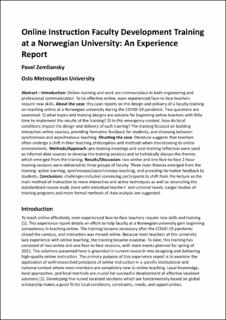Faculty development training in online instruction at a Norwegian university: An experience report
Peer reviewed, Journal article
Accepted version
Permanent lenke
https://hdl.handle.net/11250/3024888Utgivelsesdato
2021Metadata
Vis full innførselSamlinger
- ADM - Documents [35]
- Publikasjoner fra Cristin [3269]
Originalversjon
10.1109/TPC.2021.3057255Sammendrag
Introduction: Online learning and work are commonplace in both engineering and professional communication. To be effective online, even experienced face-to-face teachers require new skills. About the case: This case reports on the design and delivery of faculty training on teaching online at a Norwegian university during the COVID-19 pandemic. Two questions are examined: 1. What topics and training designs are suitable for beginning online teachers with little time to implement the results of the training? 2. In this emergency context, how do local conditions impact the design and delivery of such training? The training focused on building interactive online courses, providing formative feedback for students, and choosing between synchronous and asynchronous teaching. Situating the case: The literature suggests that teachers often undergo a shift in their teaching philosophies and methods when transitioning to online environments. Methods/approach: Pretraining and post-training reflection were used as informal data sources to develop the training sessions and to holistically discuss the themes that emerged from the training. Results/discussion: Two online and one face-to-face 2-hour training sessions were delivered to three groups of faculty. Three main themes emerged from the training: active learning, synchronous/asynchronous teaching, and providing formative feedback to students. Conclusions: Challenges included convincing participants to shift from the lecture as the main method of instruction to more interactive and active techniques, as well as reconciling the standardized course study plans with individual teachers’ instructional needs. Larger studies of training programs and more formal methods of data analysis are suggested.
